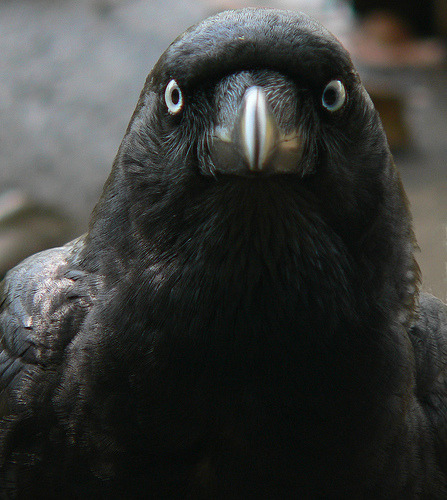(Iflscience.com, 22, October 2013) - Before 1960 most of the
work surrounding animal intelligence was centred around behaviour, with famous
experiments such as Pavlov’s dogs and Thorndike’s operant conditioning. After
1960, the field began to shift to understand animal cognition and there has
been much debate whether animals have an actual consciousness.
The full extent of what animals think may never be known,
but we already have seen amazing intelligence from some unlikely sources.
Crows
Crows are insanely intelligent creatures. They are able to
recognize human faces and hold a grudge against the ones they don’t like. In
order to study the crows they had to be collected and properly tagged. The
scientists who handled the birds quickly fell out of favor with the crows. The
next time the researchers entered the enclosure they were greeted by the crows dive bombing and attacking them. If the same researchers came back wearing a
mask that the crows hadn’t seen before, they were left alone. It also appears
that the crows conspire with one another and share information about which
humans they don’t like. Crows who were absent when a particular researcher had
handled the other birds would still respond with hostility upon seeing the
scientist at a later date.
Their amazing intelligence is not always used to start
fights - they are skilled at using tools
in order to retrieve food or solve problems. Crows readily use sticks, rocks,
and wires to retrieve food from hidden places. If the proper tool is not at
their disposal, they can actually make one to suit the job. What's more, these
crows can use tools better than many primates.
Aesop’s “The Crow and the Pitcher” fable describes crows’
ingenuity. A crow wanted a drink of water, but was unable to reach down into
the pitcher. Rather than give up, it dropped pebble after pebble into the
pitcher until the water rose high enough for it to have a drink. It is a
2600-year-old story of tenacity. Modern scientists have decided to test the
fable and found that it was scientifically accurate.
Dolphins
“So long, and thanks for all the fish.”
Dolphins have long been celebrated as some of the most
clever animals in the world. Their brains are extremely large for their body
size, have a neocortex (where higher function takes place) much more intricate
than humans and the region of the brain that is in charge of self awareness is
enlarged when compared to other animals.
Dolphins live in social societies and communication is
integral to its success. They do not have vocal cords as humans do, but use a
combination of clicks, squeaks, creaks, and buzzes to talk to their fellow
cetaceans, though scientists have not been able to discern an actual language
yet. Body language is also an important communication tool Dolphin whistles are
unique to individuals and are developed in the first month of life.
It was recently discovered that dolphins remember the
signature call of their friends, even if they hadn’t seen each other in over 20
years. This might help explain how dolphins can leave and join different pods
so easily over the course of their lifetime.
Dolphins are so intelligent that India has recently put a
ban on their captivity. India’s Ministry of the Environment and Forests has
labeled cetaceans as "non-human persons" and released a statement
saying they are not to be captured for entertainment purposes by any person or
institution, whether they are public or private.
Pigs
While it might be surprising to some pigs are quite
intelligent and many would compare that intellect to be on the same level as
dolphins and higher apes.
Part of this intellect might be because large chunks of pig
genome are virtually identical to humans, though our last common ancestor died
out 100 million years ago. Pigs love to become couch potatoes and would rather
eat, drink, smoke, and watch TV than be active; not unlike many people.
When introduced to a mirror, they were initially fascinated
by the pig in the reflection and tried to interact by nudging and vocalizing.
While they could see food in the mirror, they tried looking behind the mirror
only to end up hungry. The next time the mirror was presented, they were not
interested in their own image, but instead used the reflection to find the bowl
of food behind them in under 30 seconds.
Pigs can also be trained to learn tricks fairly easily.
However, if at first they don’t succeed, getting the courage to try again is a
long process, especially if the pig got hurt in the attempt. Researchers
speculate that the memory of the failure is a big hurdle to overcome for many
pigs. Failures in training and living conditions can affect a pig's mood, as
the animals are capable of having and expressing complex emotions.
Elephants
Elephants are the largest mammals on land, and it turns out
that they have the brains to back up the brawn.
It was recently discovered that with absolutely no training
elephants understand when humans point. While standing in between two identical
buckets, but one was filled with food, the elephants immediately chose the one
that the human had gestured. While it is remarkable that elephants are able to
spontaneously understand this body language, it becomes even more impressive
since many great apes are not capable of the same level of understanding.
Captive elephants had no greater advantage than wild
elephants with little human interaction, leading the scientists to believe that
this is an innate response, and pointing on some level may exist in elephant
populations.
In a different study highlighting the intelligence of these
pachyderms a group of elephants competed against a group of humans in a
teamwork exercise. Not only did the elephants beat the humans in the exercise,
but they were able to do it using techniques that the researchers had not
previously considered.








